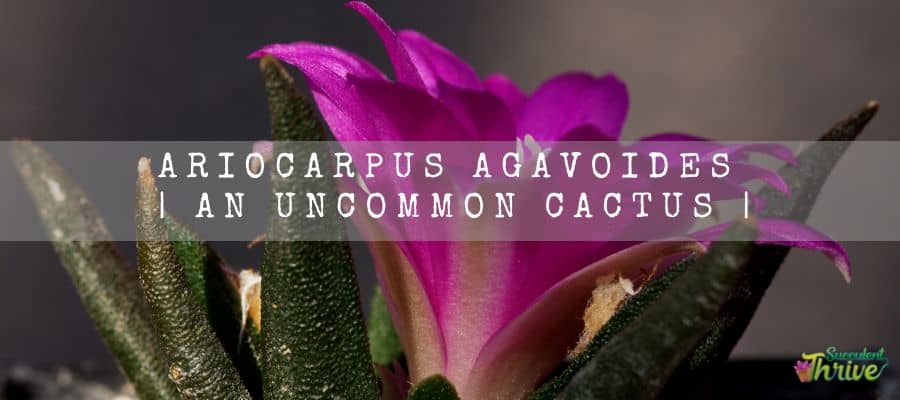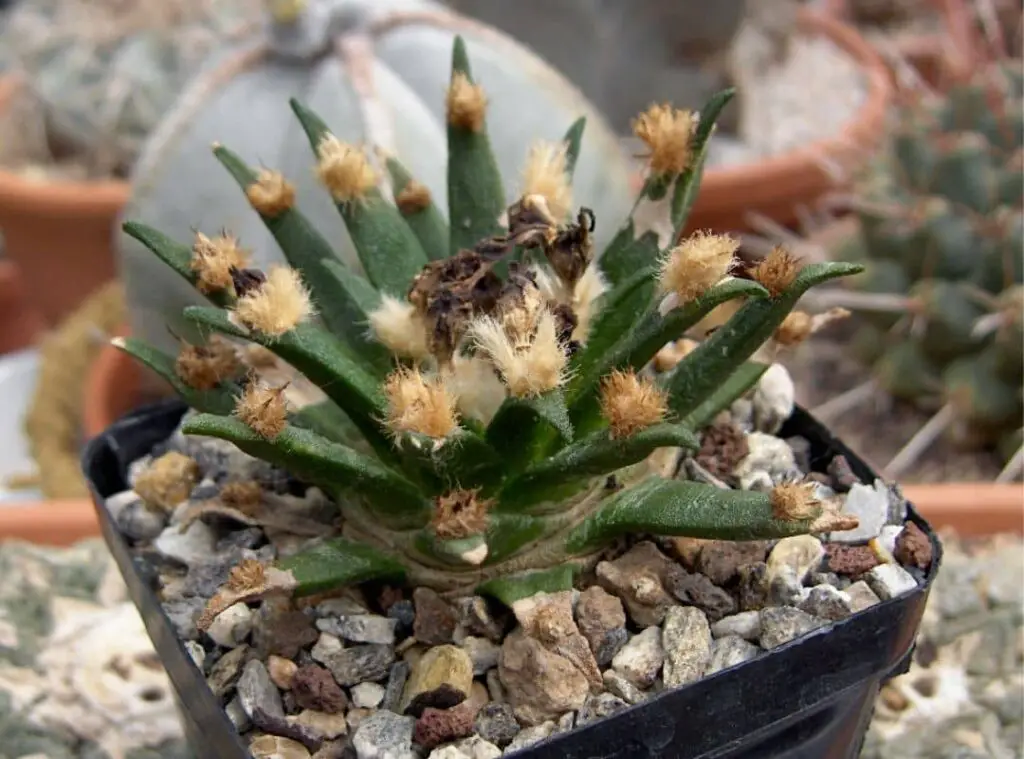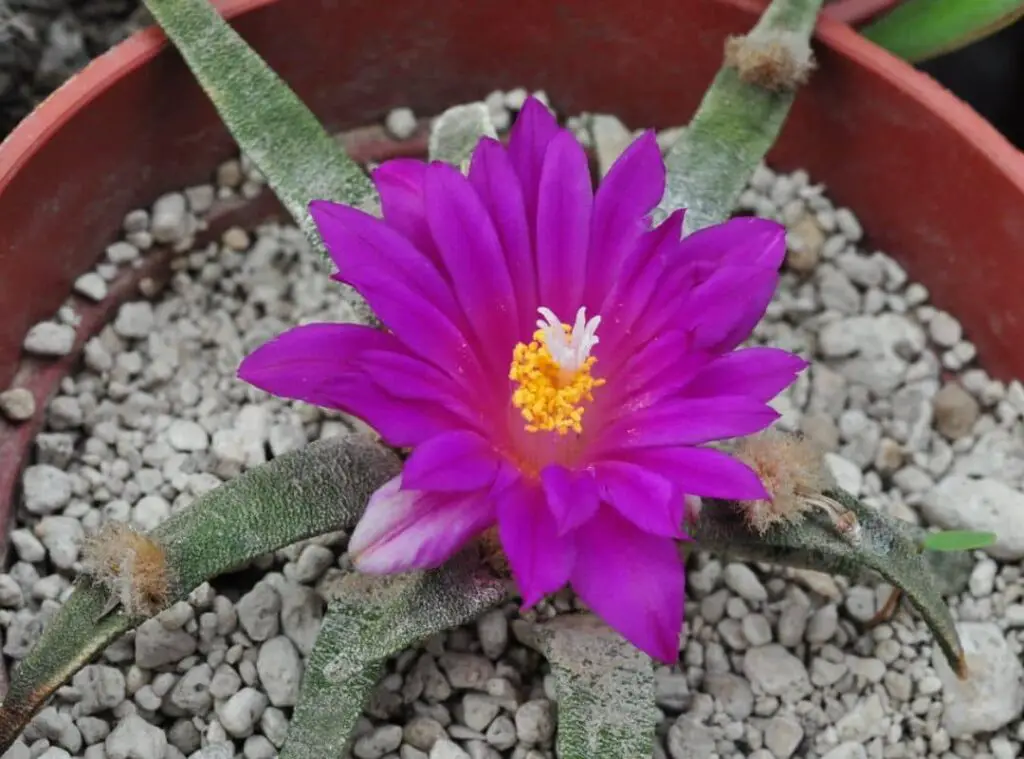Ariocarpus agavoides plants are insanely beautiful plants which are originating from Mexico. They are also known as Tamaulipas Living rock cactus in common.
These are quite popular among the succulent / cactus enthusiast for their rosette shaped appearances. Ariocarpus agavoides plants are not the type of plants which you need to provide a major care treatment as they can sustain on their own as long as you provide the basic necessities of them.
So, if you are a novice into succulent / cactus gardening, I recommend choosing Ariocarpus agavoides plants as they would-be great starter plants. So, let’s begin to explore these little charming plants.

How do I identify Ariocarpus agavoides?
You may identify Ariocarpus agavoides plants simply by observing the outlook of the plants.
Ariocarpus agavoides are rosette forming plants. Furthermore, they are short, stiff tubercles and you could spot them in dark green. The tubercles would form in a flattened manner as well.
If I elaborate on the stems ,they will tend to take a green, brown color. They would tend to take an either subglobose shape or a somewhat flattened shape.
In terms of the length of the stems, they would be about 2.4 inches ( 6cm). Further their diameter would be approximately 3.2 inches ( 8 cm). The rest of the plants would be the rootstock and they would tend to grow underground.
In addition to that, the areoles formed on the tubercle edges would be about 0.5 inches ( 1.2cm) in length.
There could be some Ariocarpus agavoides plants which come up with spines while there could be some which don’t comprise of spines. The plants which develop spines would form spines in white.
Moreover, those spines would be about 0.4 inches ( 1 cm) long. Once they mature , you could witness them carrying flowers.
Those blooms would tend to take a magenta color. In terms of the sizes of the flowers, they would be about 2 inches ( 5cm) long and 1.6 inches( 4cm) broad.
Not only that but also, once those flowers fade away , Ariocarpus agavoides plants would develop some fruit in red. Furthermore, those fruits would tend to take a globose shape. Lastly, they would be about 1 inch ( 2.5cm) broad.
Growth rate
Ariocarpus agavoides plants grow at a slow pace.
Onelook care guide
| Botanical Name | Ariocarpus agavoides |
| Common Name | Tamaulipas Living rock cactus |
| Plant Type | Cactus |
| Mature Size | maximum height of 6 cm. / 8cm broad |
| Sun Exposure | Full sunlight to partial sunlight |
| Soil Type | Well draining |
| Soil pH | Neutral |
| Bloom Time | October |
| Flower Color | magenta |
| Hardiness Zones | USDA hardiness zones 9b-11b (25 degrees Fahrenheit) ( -3.9 degrees Celsius ) to 50 degrees Fahrenheit ( 10 degrees Celsius ) |
| Native Area | Mexico |
| Toxicity | Toxic |
| Average price | 8 USD |
How do you take care of Ariocarpus agavoides?
Light Requirement
The exposure for a lot of sunlight is fundamental when you grow the Ariocarpus agavoides plants. That will encourage a healthy and vigorous growth in the plants.
If you make them deprived of sufficient sunlight, it will turn out to be unhealthy on the plants. On the other hand, the over exposure for excess and intense sunlight would also bring adverse impact on the plants.
If I further elaborate on this, if you leave them exposed to direct sunlight during the hottest hours of the day, it will lead to scorches in the plants.
Besides, if you have cultivated the plants indoors for prolonged periods and wish to bring them outdoors, I encourage you to do it in a gradual manner where you don’t expose them to full sunlight abruptly.
Best is to use shade cloth on these plants so that you can control the sunlight exposure for the plants.
Alternatively, you may shift the plants to a shady place during the intensely blazing hours of the day in summer. Having said that if you live in a temperate area, you can uncover them for direct sunlight.
Temperature and humidity
Ariocarpus agavoides plants are the type of plants which would fancy having warmer temperatures all year along just like the rest of other succulents and cactus.
Having said that, they have a frost tolerance of -10 degrees Celsius and would not tolerate colder temperatures than that.
Optimal conditions for these plants would be the room temperature or even temperature slightly lower than that.
As such, if you predict extreme colder situations, you need to ideally shift them indoors so that they will be secured from adverse changes in weather.
Humidity wise, they can tolerate a low humidity level. Refrain from exposing the plants to high humidity levels as it would lead to other unwanted issues.
Is it cold hardy?
Ariocarpus agavoides plants are somewhat cold hardy. In fact, they have a cold tolerance up to -10 degrees Celsius.
Having said that , prolonged exposure for much colder situations would deteriorate the health of the plants.
Growth Zone
The conditions in USDA hardiness zones 9b-11b (25 degrees Fahrenheit ( -3.9 degrees Celsius ) to 50 degrees Fahrenheit ( 10 degrees Celsius ) would perfectly fit in for these plants. So, if you live in the above said areas you can let them grow outdoors.

Watering Requirement
Proper watering is very crucial when it comes to assuring a robust growth of the plants.
Bear in mind to water the plants only if their soil is dry only. Further let the soil wither entirely dry between two watering sessions also.
Usually once every two weeks would suffice the water requirement in the plants. However, you may have to change frequency in watering depending on the season, the pot size etc.
Always you need to water them moderately and refrain from supplying water in excess. Over watering could turn out to be lethal on the plants. It is noteworthy, under watering is always better than over watering.
Soil Requirement Type / Ph
A soil medium which is fast draining is ideal for the Ariocarpus agavoides plants. Besides, it needs to have a good aeration as well.
So, a soil mix which is specifically made for cactus and for succulents would fulfill these two requirements and the best would be to go ahead with this choice. You may easily purchase these from local nurseries and from the garden’s stores.
I suggest you refrain from using soil mix which are generic as they are not well draining and well aerating. If you end up using a poor draining soil mix, it will retain excess moisture within the potting medium.
Consequently, it would pave the way for root rot and for other unwanted fungal and bacterial infections as well.
Pot size Potting and Repotting
Ariocarpus agavoides plants would opt to grow in pots which have a high porosity. The high porosity of the pot materials would help to release the excess moisture at a rapid rate.
In that context, terracotta pots or clay pots would be ideal for them. Furthermore, it is critical that you use a pot which has one or two draining holes so that excess water can move out from the pots without retaining.
Furthermore, when it comes to repotting, you could do it less often since these are slow growers. Ideally you may repot them once every two years.
Ensure that you do this periodically as that will allow you to observe the plants well. If you come across any totten part of the plants, you may snip them off and treat those cuttings with fungicides. Finally you may plant them in fresh pots.
Where to Plant
Ariocarpus agavoides plants would perform well both indoors and outdoors as long as they get a lot of sunlight.
Fertilizer and time of year
Ariocarpus agavoides plants do not really depend a lot on fertilizers. Having said that, I encourage you to feed the plants when they are actively growing with a succulent or a cactus fertilizer.
Ideally a fertilizer which has a low nitrogen component would be ideal for them. That would give them the extra boost they need for the healthy and vigorous growth of the plants.
Flower
Ariocarpus agavoides plants blossom with blooms in magenta color. In terms of the sizes of the plants, they would be about 2 inches ( 5cm) in length and 1.6 inches( 4cm) in width.
Those flowers may further contain greenish white margins as well. You could spot the plants emerging in October.

Dormancy
Ariocarpus agavoides go into dormancy during winter.
Toxicity
Ariocarpus contains toxic and bitter alkaloids which protect it from being eaten by animals. Aprt from that plant in genus Ariocarpus genus contains chemical called hordenine which is responsible for mild hallucination. Therefore keep this plant away from kids and pets.
Common bugs and illnesses
Ariocarpus agavoides are quite vulnerable to root rot. If you expose them to excess watering, it will make them rot.
If you water them moderately in spring , summer, and refrain from watering in winter , it is very unlikely that you will go through these conditions.
Furthermore, keep in mind that you need to supply a soil mix which is well draining too so that you do not have to combat root rot.
In addition to that, chances are that they may have to experience pests’ attacks as well. Pests such as mealybugs, scales and aphids tend to invade these plants.
Special Care tips
You should use gloves when working with these plants.
How to propagate Ariocarpus agavoides
I recommend using the seeds propagation method to make new plants. In addition to that you may graft these plants and make new plants too.
Ariocarpus agavoides benefits
Ariocarpus agavoides would make great indoor plants.
Conclusion
To recap, what we discussed in the above, Ariocarpus agavoides are such a versatile great set of plants which would flourish if you look after them well. So, I hope this article gives you insight on these spectacular looking plants and now that you are all confident in handling them.
Read Next : Peperomia Ferreyrae Dying | 7 Reasons |
